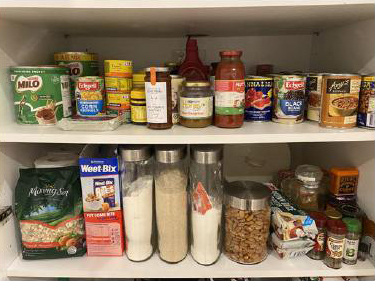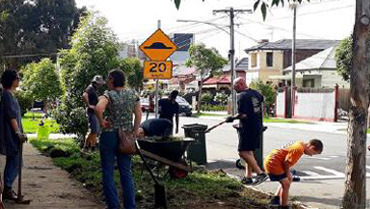See online resource with details on these topics at: https://transitionaustralia.net/resource-library/transition-streets/handbook/ or bit.ly/3rqpLxs
Food Miles – a study found that the total distance for all transportation for a typical food basket in Melbourne – 29 common food items, was 70,803 km – twice around the earth [rice 9700, sugar 2300, chips 2000, tea 8300 ] this is expected for Imported Foods, but mass produced Australian Products can also gain travel miles between picking, and packing. See 3-4 in online resource for more food miles information.
Pesticide Residues – are an issue [apples 15%, lettuce 4%, bread 2%] because weeds and pest insects love acres of monoculture, high volume farmed food. The industrialisation of rural regions also sparks social issues like worker exploitation, and animal cruel factory farming. See 3-5 in online resource.
Local & Home Grown – knowing where your food comes from, meeting the growers and makers, knowing what is in your food, and seeing your money recycle through the community. But what do the claims mean? – organic, chemical free, biodynamic, and permaculture? See 3-6 in online resource.
Raw & Fresh – general hygiene and storage is key. Wash all food preparation areas, wash and scrub home harvested produce before bringing inside, and
wash and rinse produce just before eating or making into the meal. See 3-9 in online resource.
Half Processed – longer life preserved foods – dried fruit, vegetables, and meats; dehydrated products like spaghetti; bottled and canned foods are convenient and help us extend seasonal foods, but check the ingredients list on commercial items. See 3-10 in online resource.
Ready to Eat – basically engineered food. While convenient and tasty, the ingredient list highlights the salts, sugars, colourings, and flavour agents, needed to give these an appealing appearance, a long shelf life, and to use up cheaper base ingredients. Resource 3-11.
Packaging – some packaging may be necessary for processed and bulk foods, and managing some plastic waste is less climate damaging than the current 20% of food wasted in shipping, storage, and supermarket display. Resource 3-7 and 3-8
Do It Yourself Options – start with local, low food miles, shops and farmers markets; take your own produce and
carry bags; reuse your own containers for tricky items- honey, peanut butter, cleaning liquids; and use beeswax or silicone wraps and cloth fridge bags to store foods.
Compostable – the most basic is fruit and vegetable peelings and cuttings saved for your compost bin. But by using a Bokashi type fermentation system, prepared
foods, meat, dairy, egg, coffee & tissues can also be turned into compost. Resource 3-12
Everything Eaten – thoughtful planning means no wasted food, just enough for the one meal, or a cascade of left-overs into other meals. Resource 3-13
Water Waste – hygiene and meal preparation comes first, but develop a plan for the separation and collection of this water, and use it to grow more food. Time is Money & Energy – cooking multiple
meals at the same time – so investigate pressure cooking, pans matched to tasks, microwave, solar & turbo ovens. Resource 3-14
Global food production increased 250% from 1960 to 2019 as we industrialised agriculture. Climate change impacts, and population growth, predict a further 70%increase will be needed by 2050 if we continue on the same path. The ecologic cost of having the current huge variety of out-of-season, imported, and convenience packaged foods is huge – 30% of our ecologic footprint.
More information on the real cost of food start here
https://transitionaustralia.net/resource-library/transition-streets/handbook/ – Resource 3-1
So Where Do You Stand on Food?
Let’s start wth a food audit of your meals and food sourcing. Download a general pantry and fridge audit – link above – Resource 3-2
Make note of:

Estimate Your Food Source Percentages
Using the Season Food Guide from Transition Australia, -Resource 3-3 – estimate the percentages for each aspect of your food consumption – the Raw/Fresh, Local/Home, and Australian Produce percentages will show how [ sun light powered, In Season ] compared to [ fossil fuel assisted, Out of Season / Hot House Grown ] your food currently is.
For one meal – Just for you (or organise a multi household street event ) – try to source everything from just your local region – maybe only things from your farmers market.
Over one month – Letter-box survey your neighbours asking who composts, and who has chooks, worm farms, and Bokashi bins, then suggest starting a food waste share program – swap food scraps for fresh eggs, or worm castings and juice, or just help some one with no garden manage their scraps.
One weekend – look up the OpenFood Network or online search your town and plan a family walk, bike, or car trip, to visit a community garden, food coop, organic farm, or just to find a new whole foods grocer.
During the year – look up Permablitz online. Explore going on a blitz to help out and learn garden skills, and then consider using a blitz to build or revamp your own garden
Forever – Make one day a meatless day, and then see if you can add more days.
Kids Fun – start a carrot top garden, or plant seeds in soil or potting mix in an egg carton. Give them their own space in your garden. Ask older kids to write out, and illustrate, vegetarian or local food recipes, and make a street recipe book.
